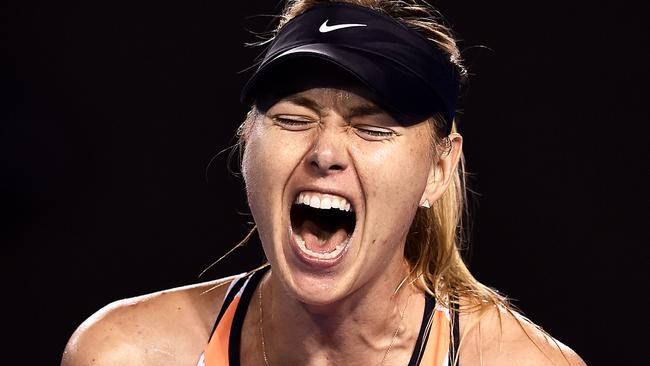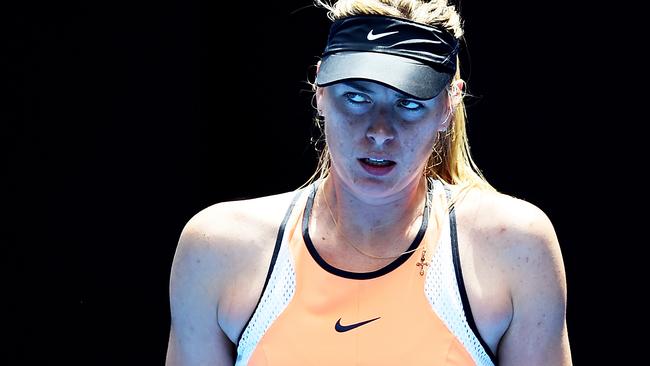Maria Sharapova in a battle to save her legacy after failing drugs test at Australian Open
WHATEVER fate ultimately befalls Maria Sharapova as she attempts to clear her name, the Russian is determined to have the last word. Don’t bet against it.

Tennis
Don't miss out on the headlines from Tennis. Followed categories will be added to My News.
WHATEVER fate ultimately befalls Maria Sharapova as she attempts to clear her name, the Russian is determined to have the last word.
Now 28, Sharapova would not be able to return to tennis until she is 32 if given a four-year ban for doping by the International Tennis Federation for taking a banned substance.
Whether the ITF tribunal rules Sharapova’s ingestion of Meldonium falls somewhere been careless, stupid or sinister is immaterial to everybody — except Sharapova.
She has already made it plain she wants to play tennis again; to win another major.
She can and probably will given the fact Serena Williams will be 35 this year and might be almost 40 by the time Sharapova comes back in a worst-case scenario.
Regardless of whether Sharapova gets 12 months or four years, she is young enough to come back.
Women’s tennis is full of precedents proving serious interruptions — for the best and worst reasons — are not automatically career-ending.
Margaret Court, Evonne Goolagong and Kim Clijsters all took time away from the sport to start families and returned to excel.
Albeit injury-plagued, Sharapova still has youth on her side.
And she already knows what it is to return to competition after lengthy lay-offs.
Shoulder surgeries in 2008 and 2011 sidelined Sharapova for several months but she re-emerged with fresh energy and signature determination.
Her nemesis Williams has also missed large chunks of her career because of a string of health issues.
Williams is now on the cusp of history, sitting third behind only Court and Steffi Graf on the all-time grand slam champion’s list.
Her Indian summer has been astonishing.
Why not Sharapova?
Pride has long been the spur that drives the baseliner.
With estimated annual off-court earnings approaching $40 million, Sharapova does not play for prizemoney.

She plays to win and, with 35 singles titles and an Olympic medal, has constantly scaled the heights.
One of the messages to resonate from a difficult, sometimes emotional and occasionally prickly media conference on Tuesday, was Sharapova’s desire to finish on her terms.
There was also a palpable sense of doubt and uncertainty — natural symptoms of the dilemma she now finds herself in.
But Sharapova is nothing if not a survivor.
When she emerged as a 17-year-old to trounce Serena Williams and march to the Wimbledon title, the travails of her childhood were lost in the fixation of her beauty.
Sharapova’s journey from Sochi in Russia included long separations from her mother after she travelled as a six-year-old to chase her tennis dream — and her volatile father Yuri’s — in the US.
Unable to speak English and forced to fend for herself for long periods as Yuri worked several low-paid jobs to finance his daughter’s tennis tuition, Sharapova did it tough.
Eventually reunited with her mother Yelena, Sharapova had already started the transformation from innocent to hard-bitten.
At Wimbledon 12 years ago, she was dubbed “The Snake” in the locker-room because of her toughness and infamously remote personality.
The seeds had been sown and it’s why, regardless of what happens, Sharapova is unlikely to walk away from tennis.
Sponsors such as Nike and Porsche might be anxious over the fate — more likely reputation and marketability — but Sharapova will have a clear vision of how she wants the next phase to play out.
Suspension is inevitable.
She has admitted fault and is prepared to wear the penalty.
Given her enormous resources, expect the arguments mounted by her legal team to be comprehensive and persuasive.
The common estimate among tennis, legal and anti-doping authorities over likely penalty ranged between 12 months and two years.
If it’s at the shorter end, Sharapova can concentrate on repairing a battered body and reset.
If the ban is longer, the question of a comeback will rest on ambition.
A quick review of Sharapova’s victory at January’s Australian Open over Belinda Bencic and the stunning first set of her clash with Serena Williams will provide the answer.
Don’t expect Sharapova to take her leave tennis as a tarnished and belittled drug cheat.
Her image, not to mention ambition, is far too powerful for that.


